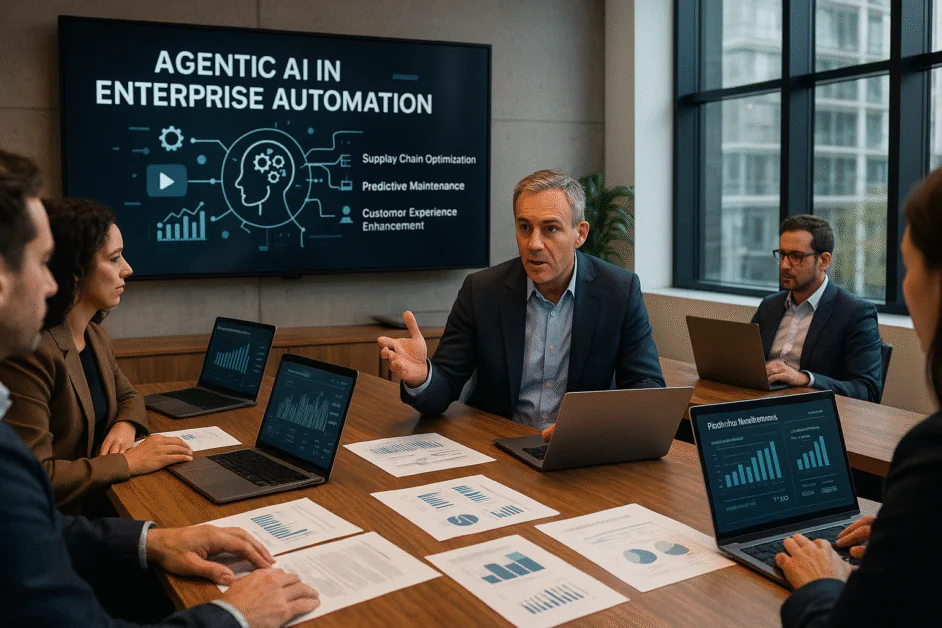Evaluating Where to Implement Agentic AI in Your Business
Agentic AI has the potential to reshape several industries by enabling autonomous decision-making, real-time adaptability, and proactive problem-solving. As businesses strive to enhance operational efficiency, they face the challenge of deciding how and where to implement agentic AI for maximum impact. From supply chain optimization to predictive maintenance and customer experience enhancement, enterprise leaders must […] The post Evaluating Where to Implement Agentic AI in Your Business appeared first on Unite.AI.


Agentic AI has the potential to reshape several industries by enabling autonomous decision-making, real-time adaptability, and proactive problem-solving. As businesses strive to enhance operational efficiency, they face the challenge of deciding how and where to implement agentic AI for maximum impact. From supply chain optimization to predictive maintenance and customer experience enhancement, enterprise leaders must carefully evaluate which areas of their business stand to gain the most benefit from agentic AI. A strategic framework for assessing AI integration opportunities is critical to ensuring that investments align with business objectives, drive measurable outcomes, and maintain a balance between automation and human oversight.
Understanding AI Evolution
To understand the role of agentic AI, we must first distinguish it from traditional AI implementations. Historically, enterprises have leveraged AI to analyze historical data, generate insights, and even make recommendations. However, these systems generally require human intervention to execute decisions and workflows. For example, a machine learning algorithmic system generates new observations, refines its models, and improves over time but never makes decisions, whereas standard AI recommends actions based on its learned experiences, potentially generating one action to move ahead a single step.
Agentic AI introduces autonomy into the equation. Instead of merely suggesting actions, agentic AI executes them, acting in real-time to solve problems and optimize workflows with multiple AI agents operating in parallel. The key differentiator lies in the concept of agents—independent AI entities that take action based on learning mechanisms and real-world conditions. A single AI agent might reorder inventory when stock runs low, while agentic AI—comprising multiple agents—could coordinate an entire supply chain response, adjusting procurement, transportation, and storage conditions dynamically.
Instead of executing a decision tree, agentic AI adapts based on real-time inputs, learning from its ever-changing environment and modifying its actions accordingly. For example, in food retail, a rule-based system might follow a structured compliance workflow—such as alerting a manager when a refrigeration unit exceeds a set temperature threshold. An agentic AI system, on the other hand, could autonomously adjust refrigeration settings, reroute impacted shipments, and reorder inventory—all without human intervention.
In a highly dynamic environment like airline logistics, a fully agentic AI network simultaneously analyzes all affected travelers, rebooks flights, notifies ground services, and communicates seamlessly with customer service representatives—all in parallel, reducing disruptions and improving efficiency.
Managing Agentic AI Autonomy Levels
As the AI evolution continues, agentic AI will gain more autonomy and handle increasingly complex decision-making scenarios. In the future, AI agents will collaborate across industries and make context-aware decisions. The challenge moving forward will be determining the right balance between full automation and human oversight for excursion management, mistake prevention, and system lockdowns. Businesses must carefully consider the risk thresholds for different workflows, implementing safeguards to prevent unintended actions while maximizing the potential gains from AI-driven advancements.
Leaders across industries should consider the areas where agentic AI is particularly valuable, where decision-making needs to be real-time, adaptive, and highly scalable. Key business functions that stand to benefit the most include supply chain and inventory management. Fleets of AI agents are able to monitor stock levels, predict demand fluctuations, and autonomously reorder products to reduce waste, avoid unnecessary loss, and finetune logistics outcomes.
In predictive maintenance, agentic AI analyzes equipment health, detects potential failures, and proactively schedules maintenance to reduce downtime. Compliance and risk management functions can also benefit, as AI oversees compliance workflows in regulated industries, automatically adjusting SOPs to meet evolving requirements.
Steps to Successful Agentic AI Adoption
To ensure successful agentic AI adoption, business leaders should follow a structured evaluation process.
- Identify high-impact use cases by assessing business functions where real-time decision-making improves efficiency and reduces the administrative burden on customers or employees.
- Define risk tolerance and oversight mechanisms by establishing safeguards, approval processes, and intervention points to balance AI autonomy with human oversight.
- Ensure AI investments align with business objectives, focusing on applications that deliver measurable ROI and support broader strategic goals.
- Start small and scale gradually by launching pilot programs in controlled environments before expanding agentic AI deployment across the enterprise.
- Evaluate agentic AI programs regularly, refining models based on outcomes and a continuous improvement approach.
With the move to agentic AI, we’ll see a significant leap forward in enterprise automation, enabling businesses to move beyond insights and recommendations into autonomous execution. Successful implementation of agentic AI will require strategic consideration of workflow design, risk management, and governance structures. Business leaders who move quickly and thoughtfully will maximize efficiency, enhance resilience, and future-proof their operations.
The post Evaluating Where to Implement Agentic AI in Your Business appeared first on Unite.AI.




























![Apple Pay, Apple Card, Wallet and Apple Cash Currently Experiencing Service Issues [Update: Fixed]](https://images.macrumors.com/t/RQPLZ_3_iMyj3evjsWnMLVwPdyA=/1600x/article-new/2023/11/apple-pay-feature-dynamic-island.jpg)












































![iPhone 17 Air Could Get a Boost From TDK's New Silicon Battery Tech [Report]](https://www.iclarified.com/images/news/97344/97344/97344-640.jpg)
![Vision Pro Owners Say They Regret $3,500 Purchase [WSJ]](https://www.iclarified.com/images/news/97347/97347/97347-640.jpg)
![Apple Showcases 'Magnifier on Mac' and 'Music Haptics' Accessibility Features [Video]](https://www.iclarified.com/images/news/97343/97343/97343-640.jpg)
![Sony WH-1000XM6 Unveiled With Smarter Noise Canceling and Studio-Tuned Sound [Video]](https://www.iclarified.com/images/news/97341/97341/97341-640.jpg)




































































































































































































































![[The AI Show Episode 147]: OpenAI Abandons For-Profit Plan, AI College Cheating Epidemic, Apple Says AI Will Replace Search Engines & HubSpot’s AI-First Scorecard](https://www.marketingaiinstitute.com/hubfs/ep%20147%20cover.png)
























![How to Enable Remote Access on Windows 10 [Allow RDP]](https://bigdataanalyticsnews.com/wp-content/uploads/2025/05/remote-access-windows.jpg)






























































































































































-Marathon-Gameplay-Overview-Trailer-00-04-50.png?width=1920&height=1920&fit=bounds&quality=70&format=jpg&auto=webp#)









































































